- Minister of Education applauds the Research Focus of SRMAP November 19, 2020
covai mail Nov-19
Continue reading →
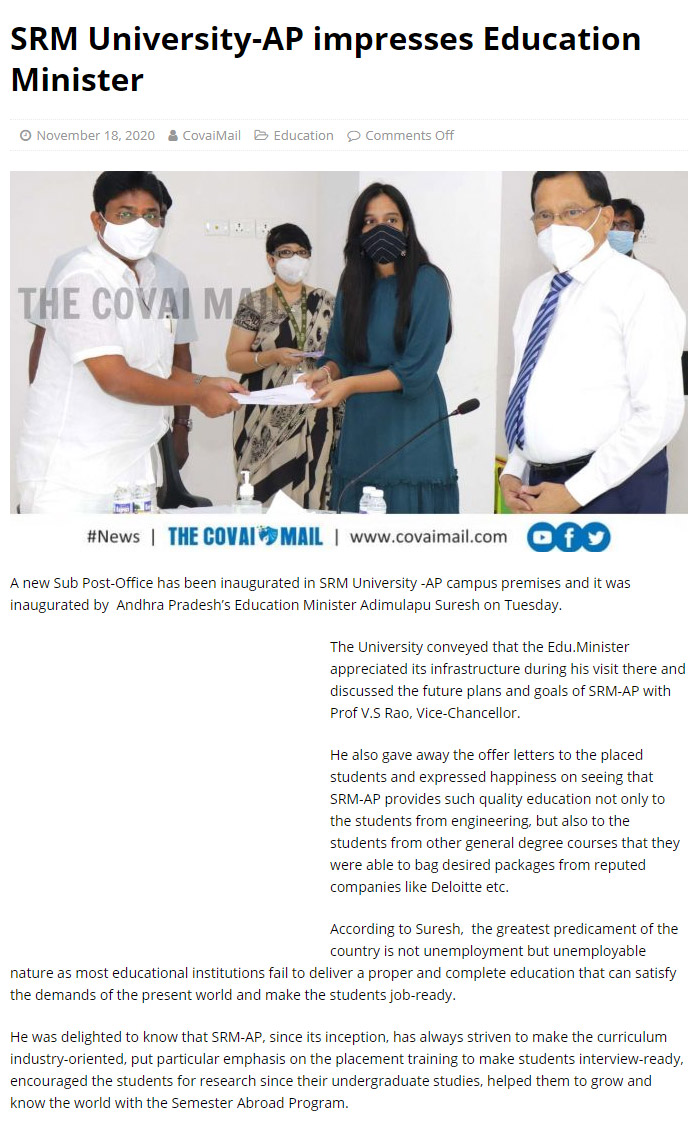
global greenews Nov-19
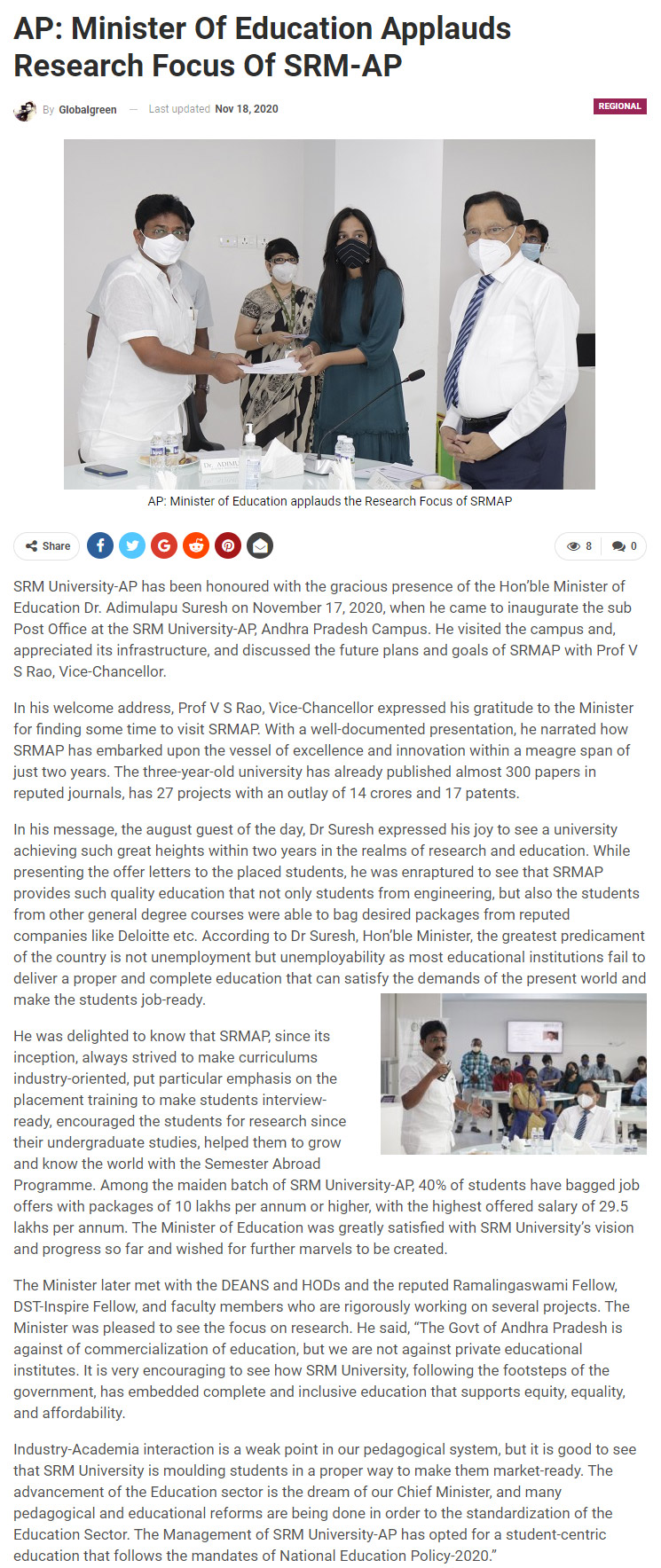
news19tv Nov-19
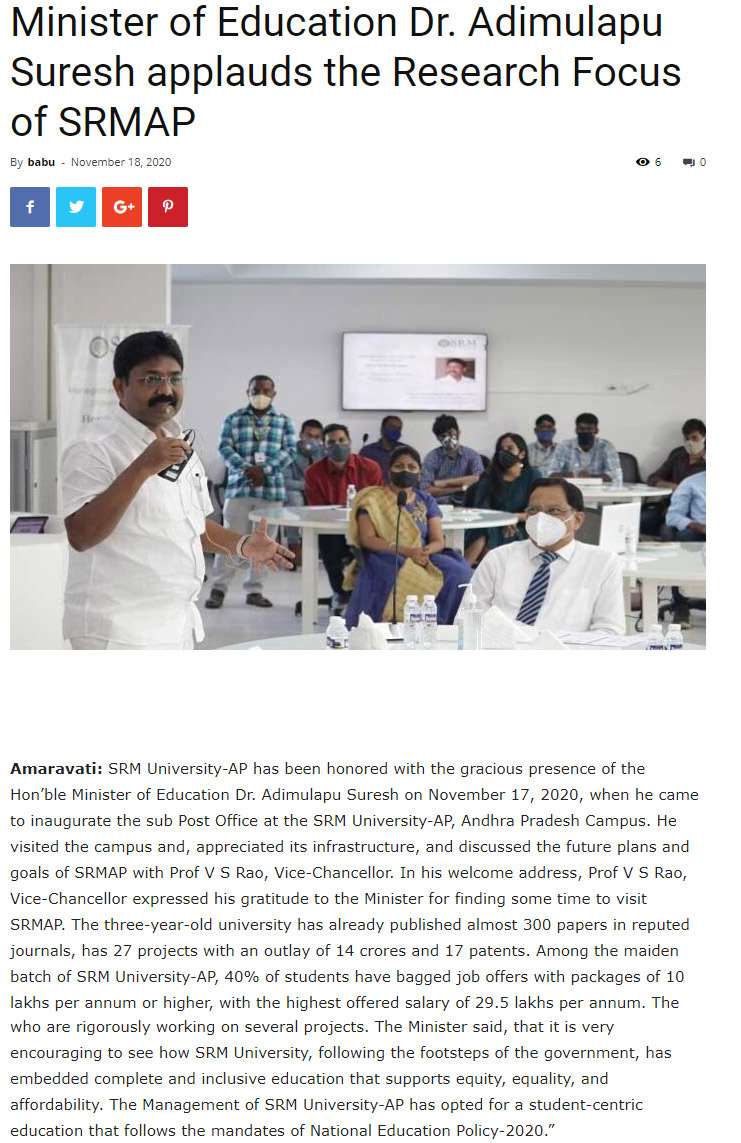
technology for you
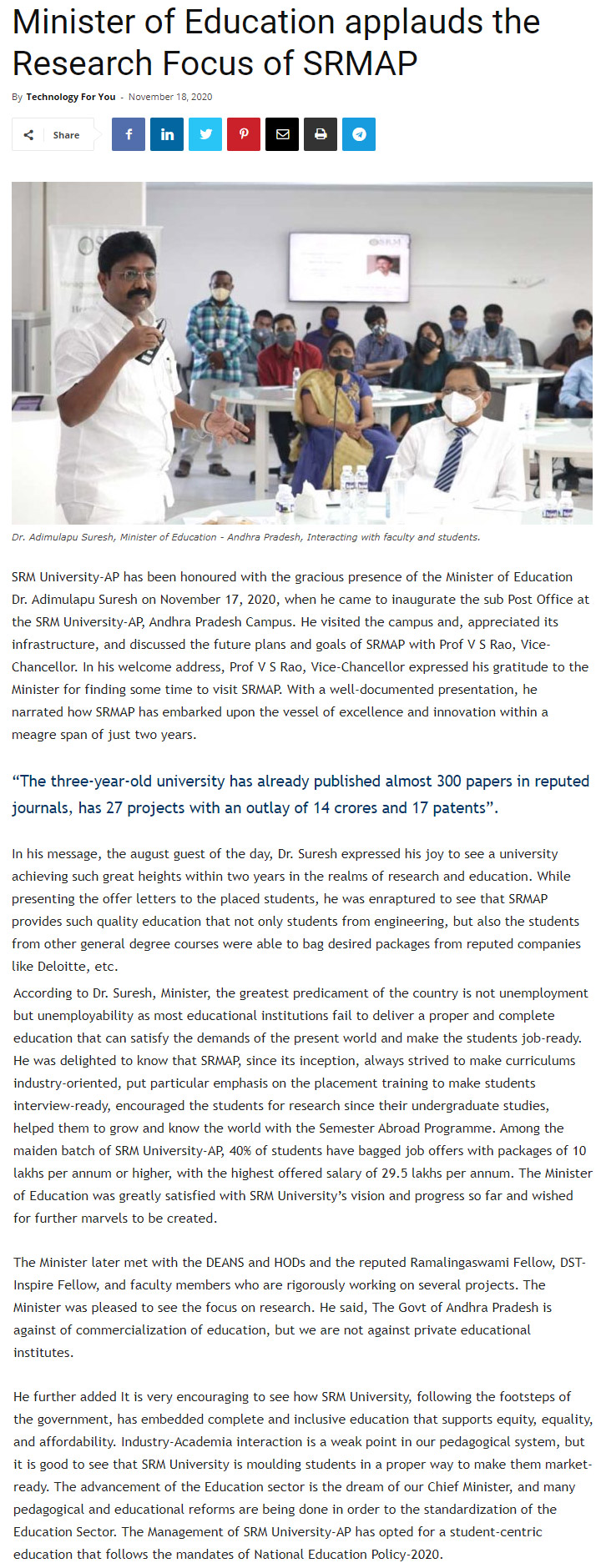
the hawk Nov-19
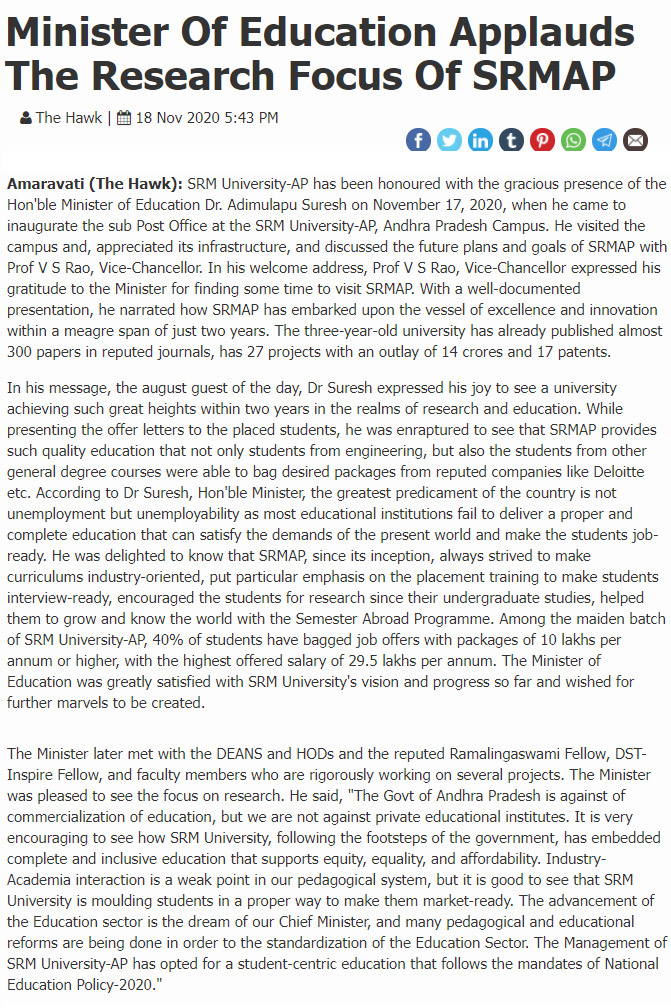
higher education digest
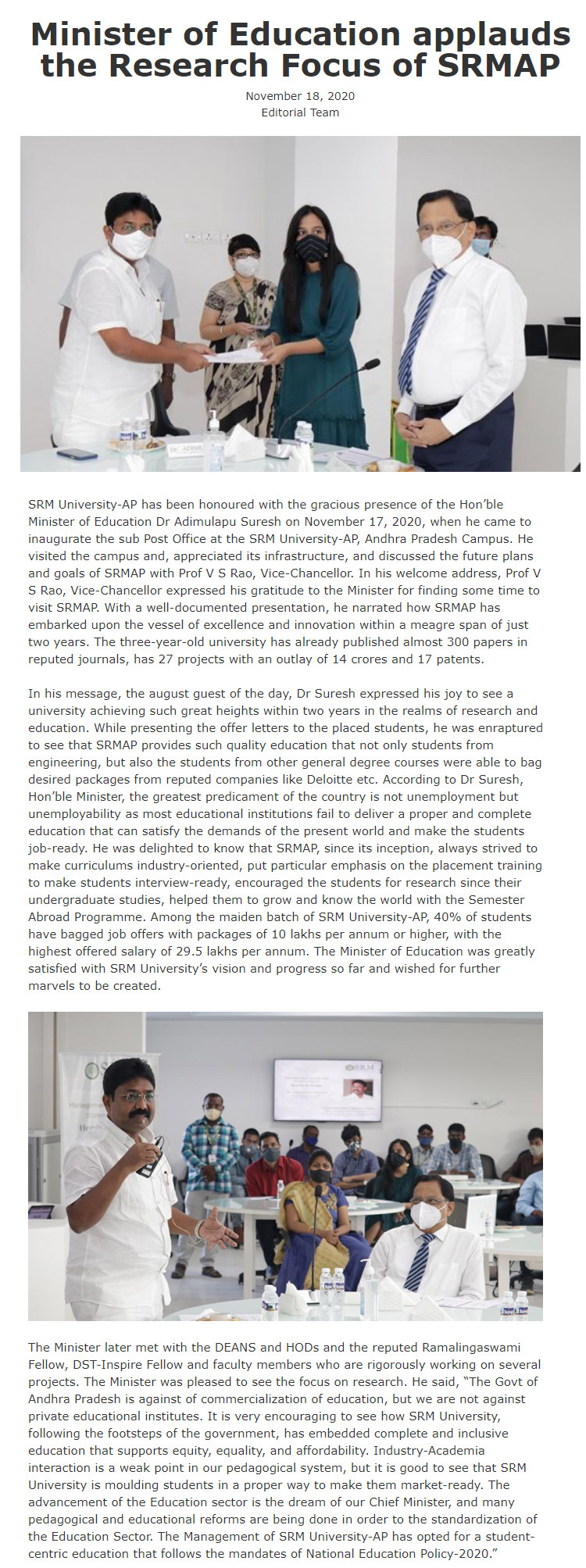
media bulletins Nov-19
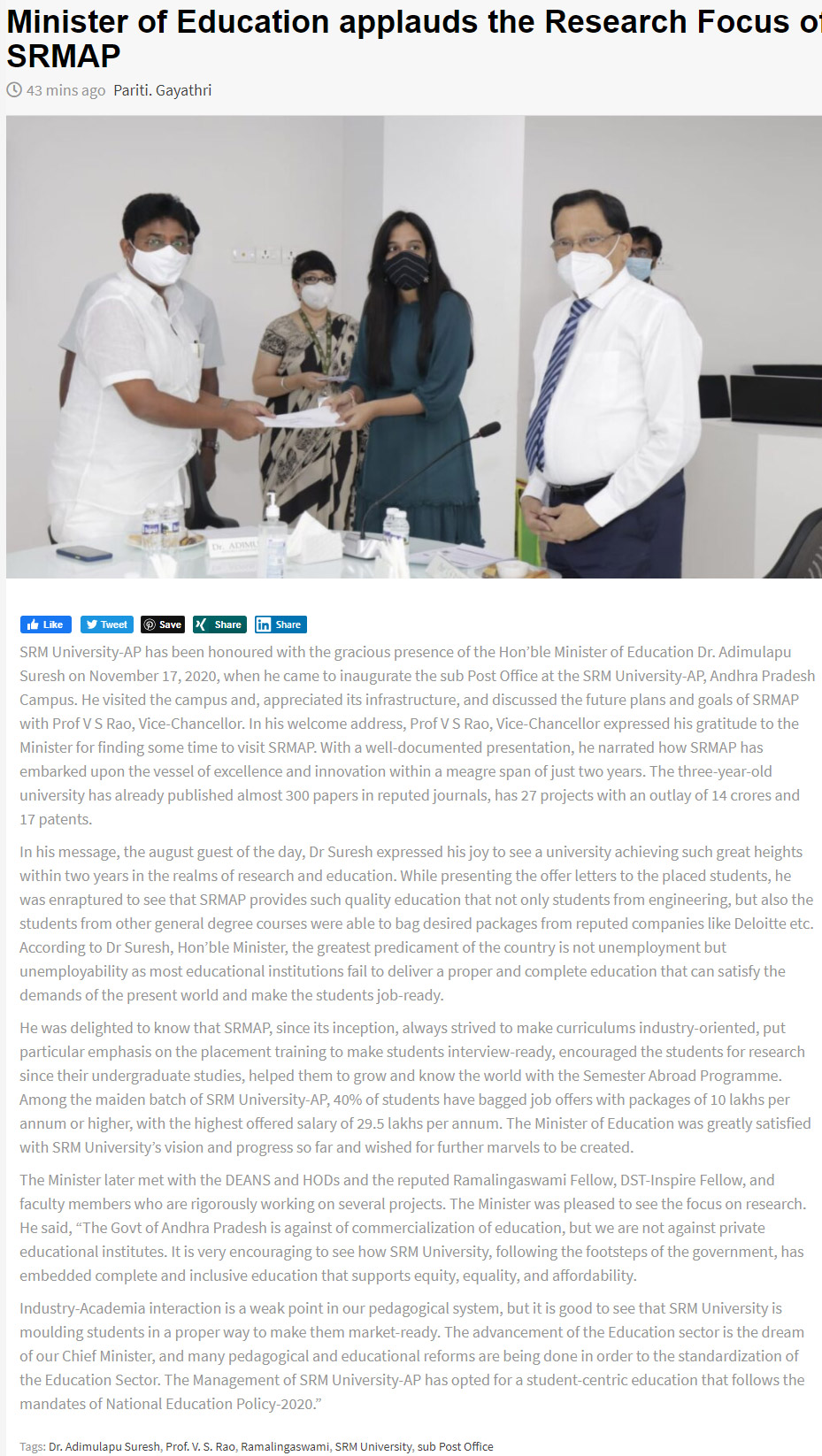
business news this week Nov-19
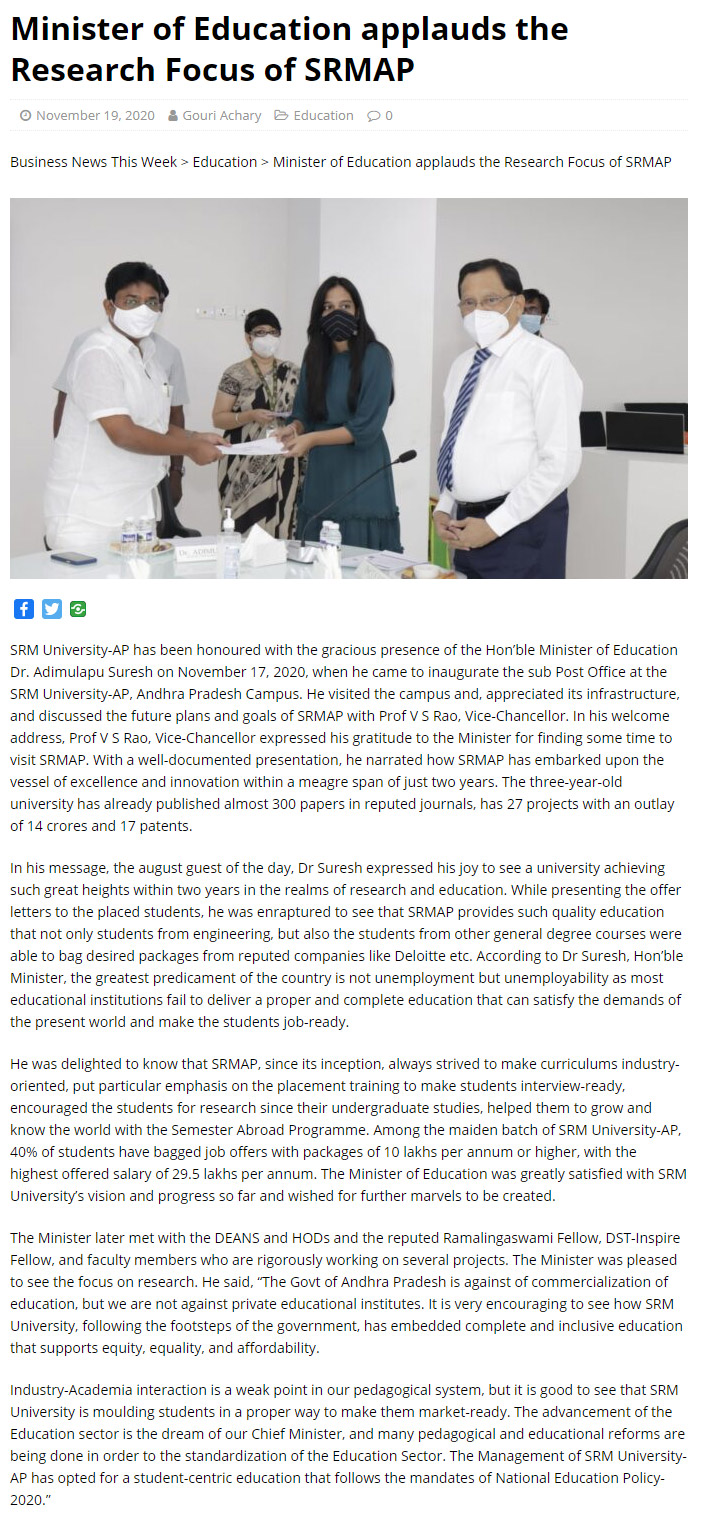
- Dr Goutam Kumar Dalapati develops high-performance photodetectors with improved electrical parameters November 19, 2020
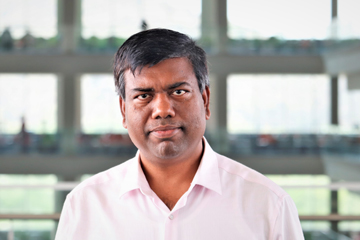 Dr Goutam Kumar Dalapati, Associate Professor, Department of Physics, SRM University-AP, Andhra Pradesh, published a research paper “Improvement on Photoresponse Properties of Self-Powered ITO/InP Schottky Junction Photodetector by Interfacial ZnO Passivation” in the reputed Journal of Electronic Materials, Springer. Photodetection has emerged as the key technology in contemporary science because of their wide range of applications in daily life and in industry, including astronomy, surveillance, environmental monitoring, machine vision, and cameras in smart phones. Commercial photodiodes should meet the criteria of high charge carrier mobility, small exciton binding energy, and higher stability. This intrigued Dr Goutam to indulge in the study of photodetector which is essential to improve several electrical parameters such as low power consumption, and higher sensitivity.
Dr Goutam Kumar Dalapati, Associate Professor, Department of Physics, SRM University-AP, Andhra Pradesh, published a research paper “Improvement on Photoresponse Properties of Self-Powered ITO/InP Schottky Junction Photodetector by Interfacial ZnO Passivation” in the reputed Journal of Electronic Materials, Springer. Photodetection has emerged as the key technology in contemporary science because of their wide range of applications in daily life and in industry, including astronomy, surveillance, environmental monitoring, machine vision, and cameras in smart phones. Commercial photodiodes should meet the criteria of high charge carrier mobility, small exciton binding energy, and higher stability. This intrigued Dr Goutam to indulge in the study of photodetector which is essential to improve several electrical parameters such as low power consumption, and higher sensitivity.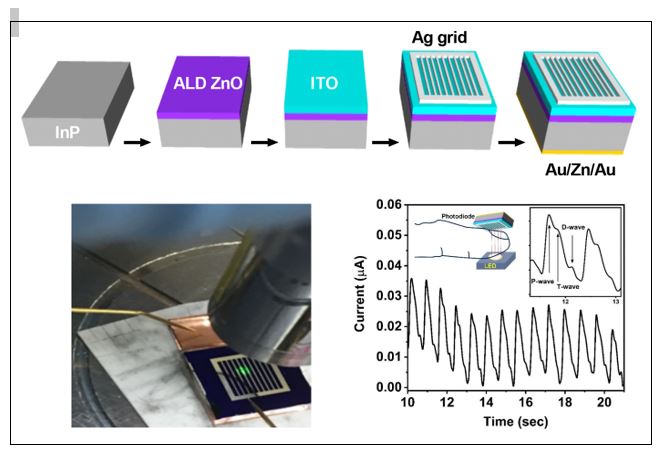 In this research, Dr Goutam developed a high-performance photodetector using Indium phosphide/indium tin oxide (InP/ITO) semiconductor metal junction. He explains, “Photodetection in semiconductors follows the principle of generating electron-hole pairs under incident light higher than or equal to its bandgap. In Schottky type photodiode, at thermal equilibrium, the Fermi levels of the metal and the semiconductor are equalized, and a transfer of electronic charge occurs from the semiconductor to the metal. Moreover, these charge transport properties can be simply tailored by compositional engineering, which provides plenty of space to modulate the performance metrics of the photodetectors. During my research, the atomic layer deposition of zinc oxide (ZnO) on the InP surface was found to increase the valence band offset for current conduction in the photodiode. Photoresponse properties were believed to improve through effective hole blocking by the ZnO interface layer which further prevents the surface recombination of photo-induced generated electron-hole pair. Through my research, I deciphered that the ITO/ZnO/InP photodiode exhibited a maximum photoresponsivity of 44.2 mAW−1 under a 520 nm laser irradiation with an illumination power of 1 μW at the zero bias voltage.”
In this research, Dr Goutam developed a high-performance photodetector using Indium phosphide/indium tin oxide (InP/ITO) semiconductor metal junction. He explains, “Photodetection in semiconductors follows the principle of generating electron-hole pairs under incident light higher than or equal to its bandgap. In Schottky type photodiode, at thermal equilibrium, the Fermi levels of the metal and the semiconductor are equalized, and a transfer of electronic charge occurs from the semiconductor to the metal. Moreover, these charge transport properties can be simply tailored by compositional engineering, which provides plenty of space to modulate the performance metrics of the photodetectors. During my research, the atomic layer deposition of zinc oxide (ZnO) on the InP surface was found to increase the valence band offset for current conduction in the photodiode. Photoresponse properties were believed to improve through effective hole blocking by the ZnO interface layer which further prevents the surface recombination of photo-induced generated electron-hole pair. Through my research, I deciphered that the ITO/ZnO/InP photodiode exhibited a maximum photoresponsivity of 44.2 mAW−1 under a 520 nm laser irradiation with an illumination power of 1 μW at the zero bias voltage.”For the successful implementation of the proposed ITO/ZnO/InP photodiode in the manufacturing levels, significant efforts are essential. Dr Goutam acknowledges that device to device variability must be addressed which arise from the deposition condition of the ZnO layer by atomic layer deposition. Surface defects reduction and selection of charge collecting electrodes must be optimized to improve the performance of the photodetector. Thus, Dr Goutam will dedicate his future research work to study patterned 2D graphene-based electrode to improve the performance. Also, n-type 2D MoS2 and hexagonal boron nitride (hBN) passivation will be studied by him on the III-V semiconductor surface for better photoresponsivity.
Continue reading → - Sub-Post Office at SRMAP November 18, 2020
The Hindu Nov-18
Continue reading →
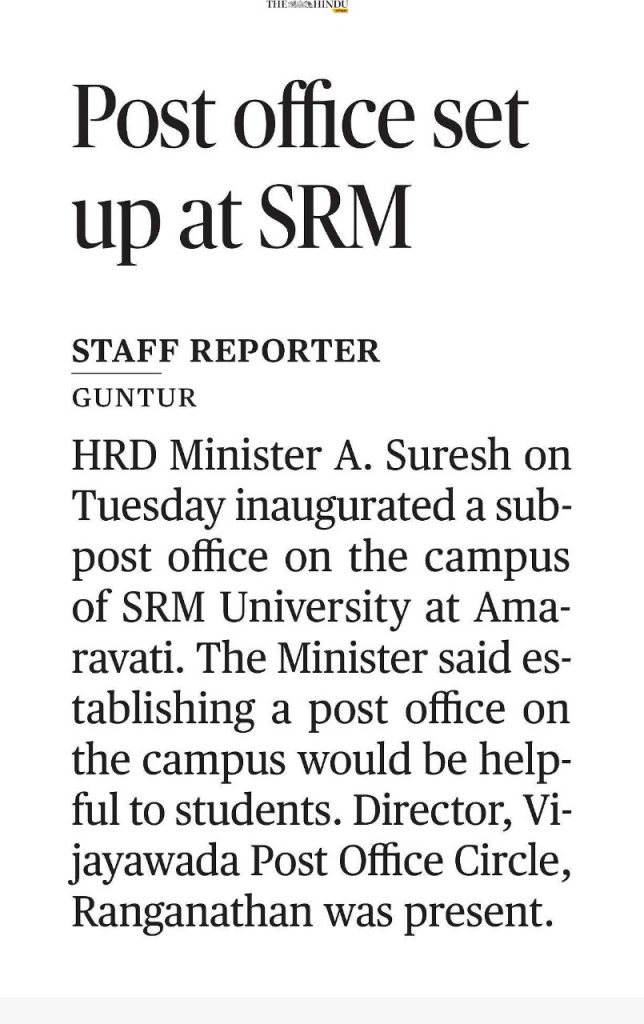
Deccan Chronicle Nov-18

Daily Pioneer Nov-18

Hans India Nov-18
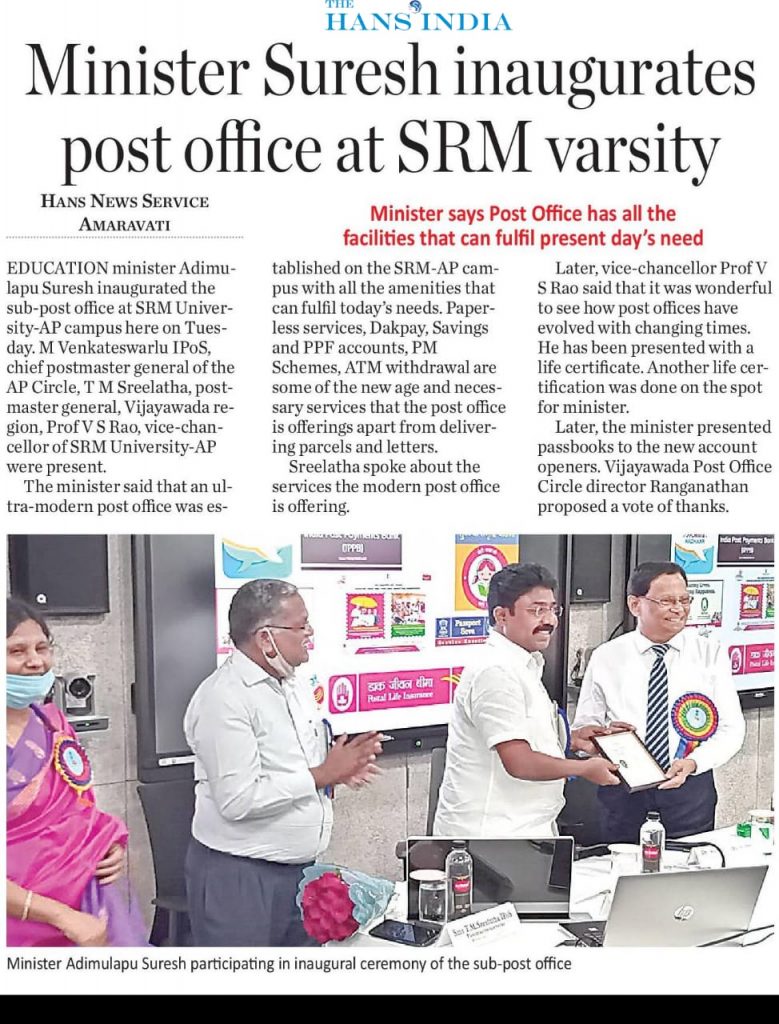
Eenadu Nov-18
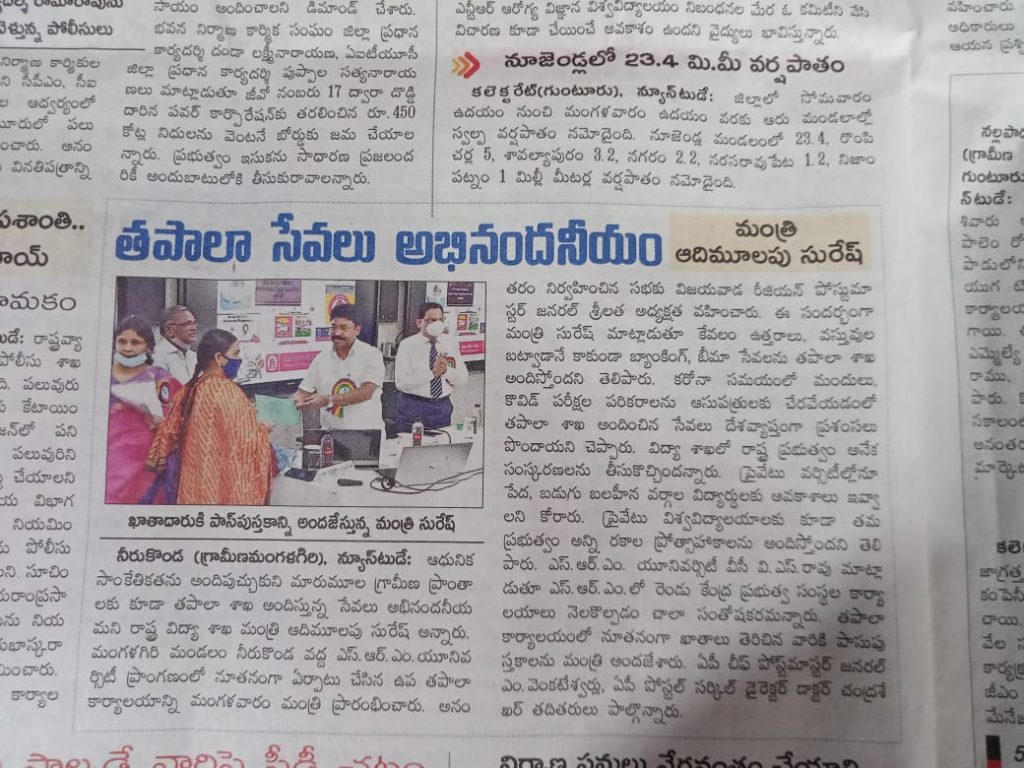
Sakshi Nov-18
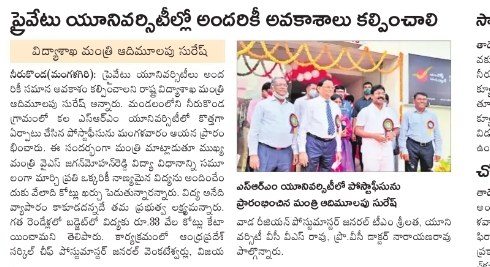
Andhra Jyothi Nov-18
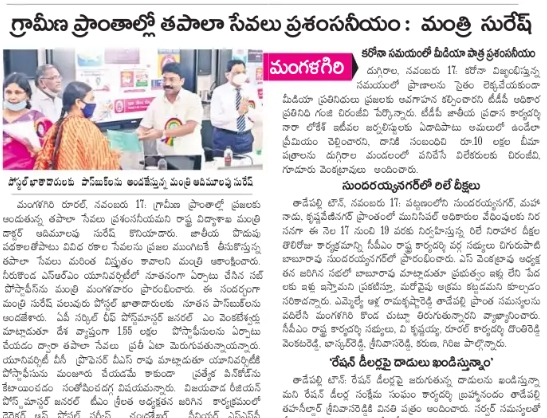
Andhra Prabha Nov-18
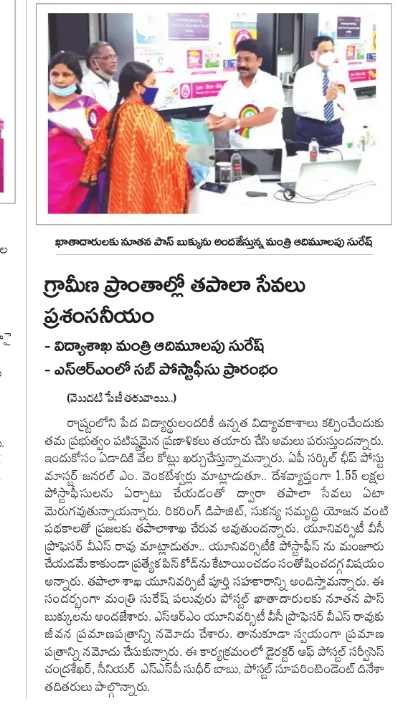
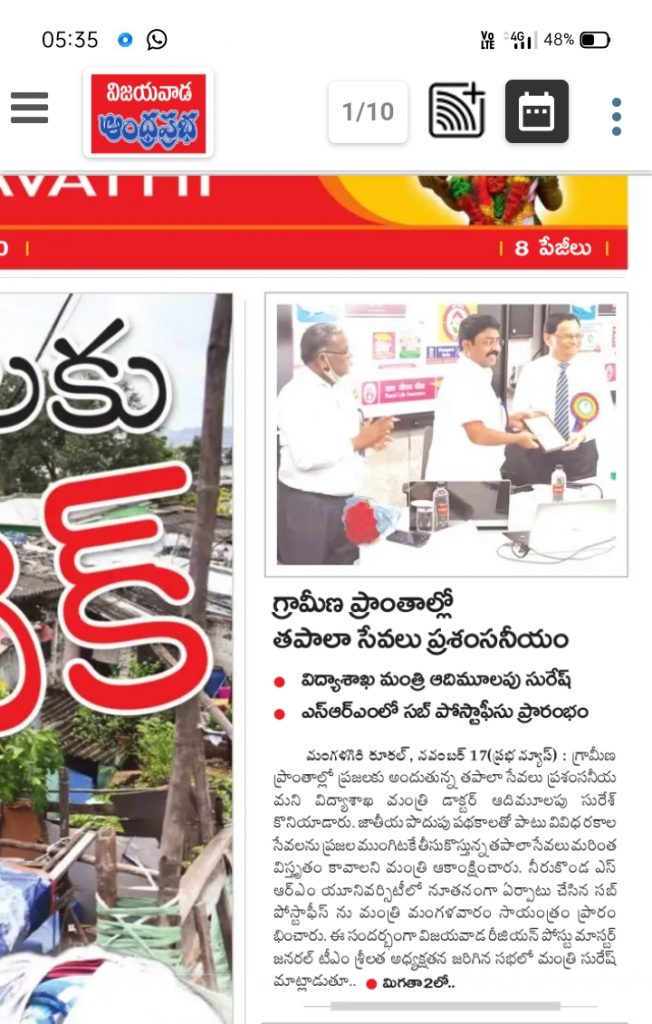
Sakshi Nov-18
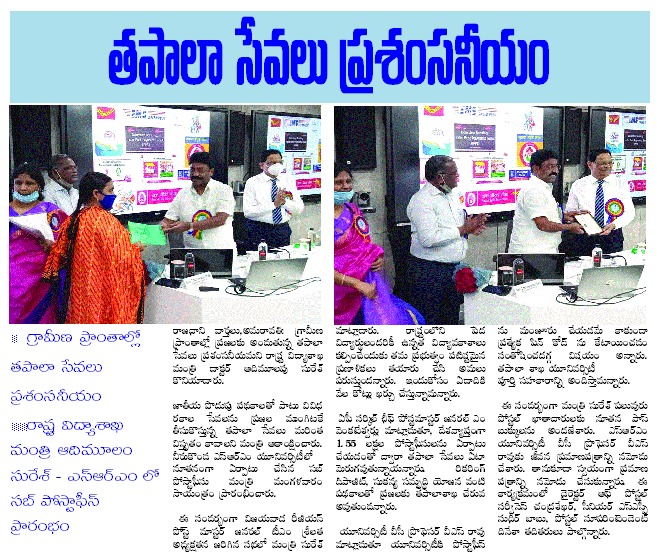
United News of India Nov-18
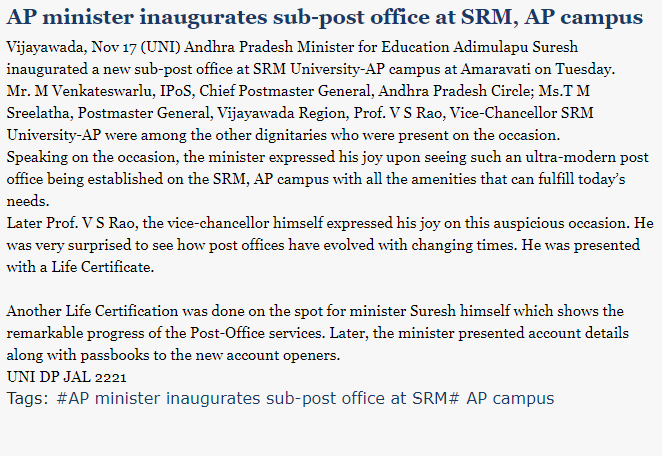
India Education Diary Nov-18
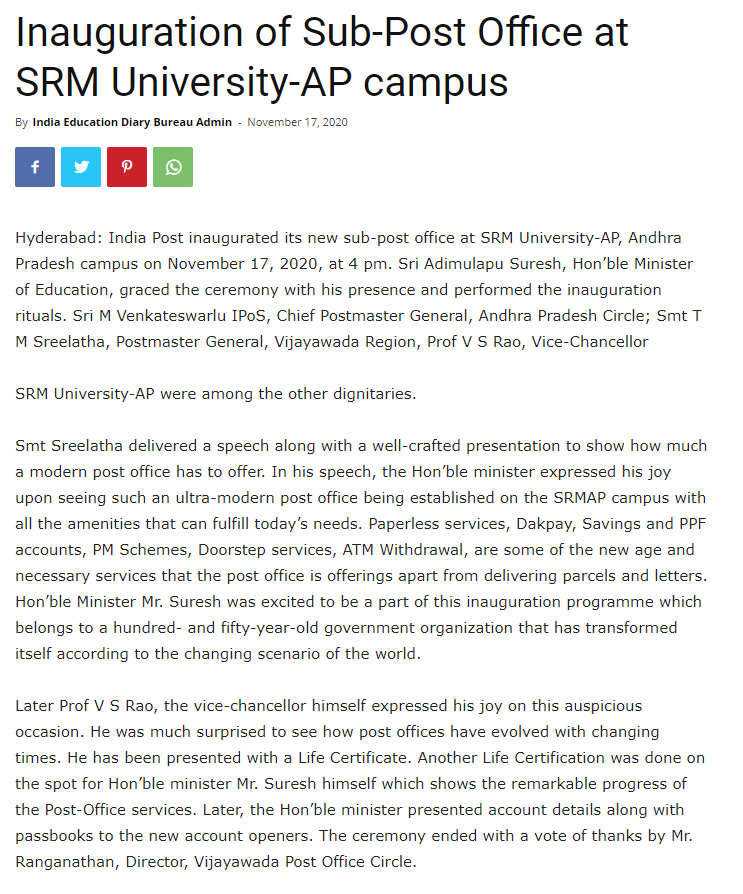
Higher Education Digest Nov-18
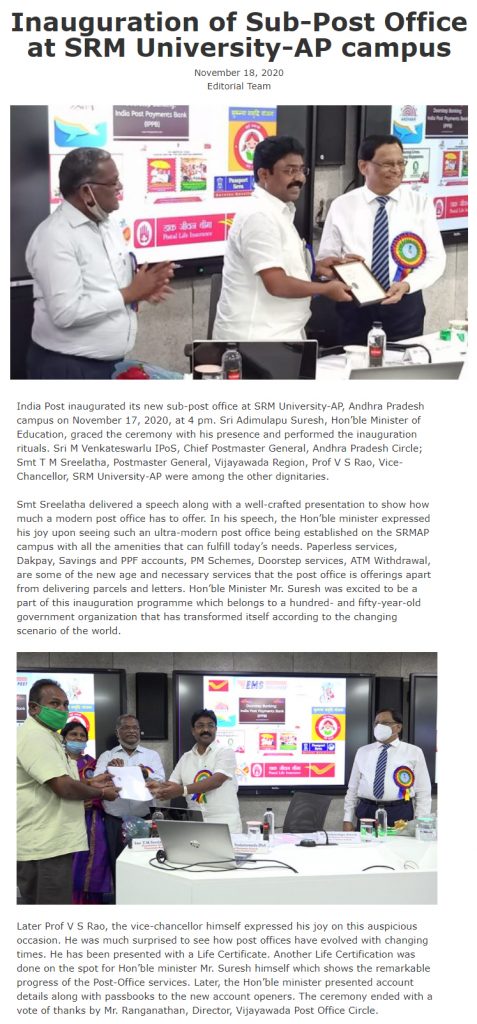
Media Bulletins Nov-18
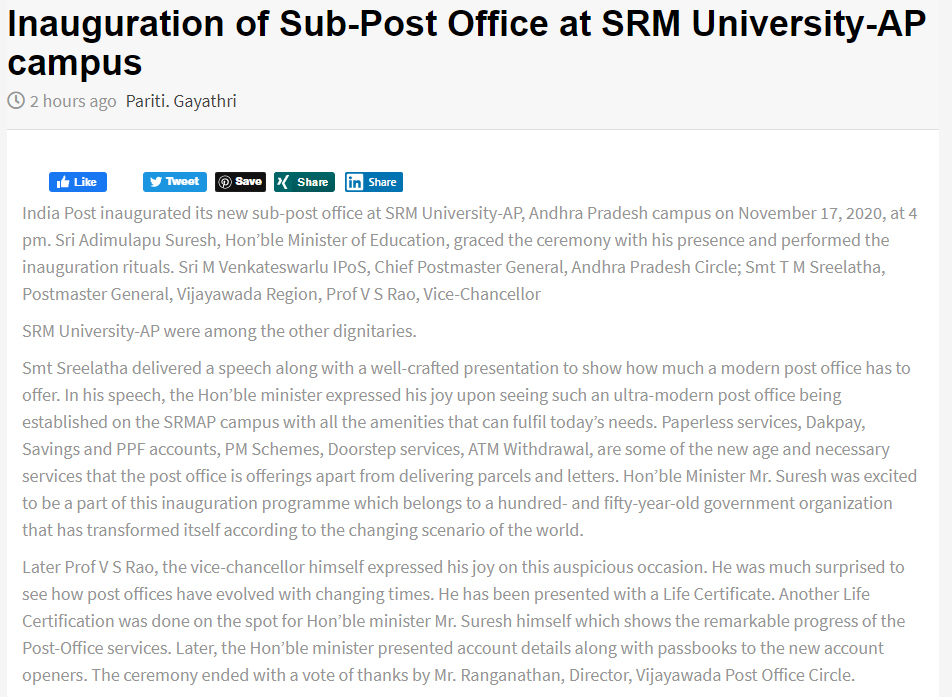
Global Green News Nov-18
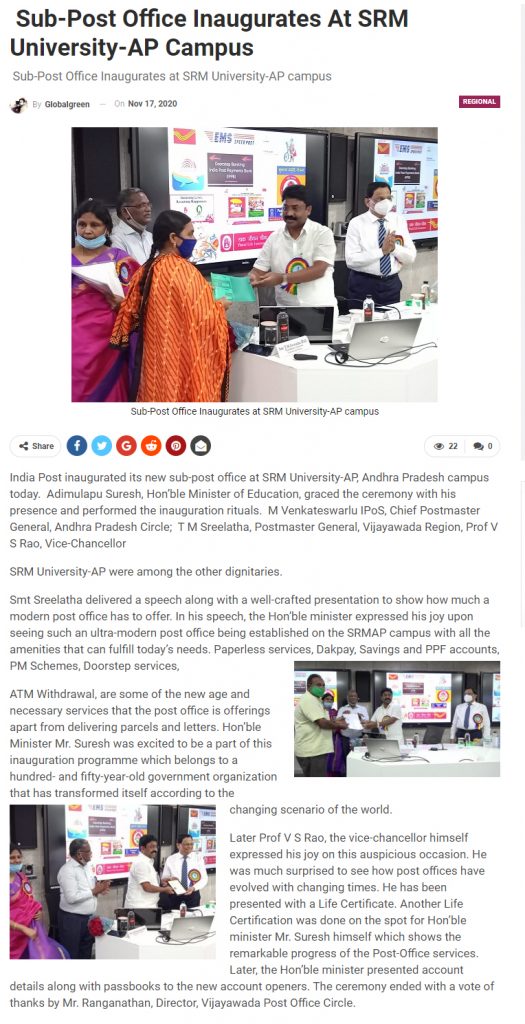
Business News This Week Nov-18
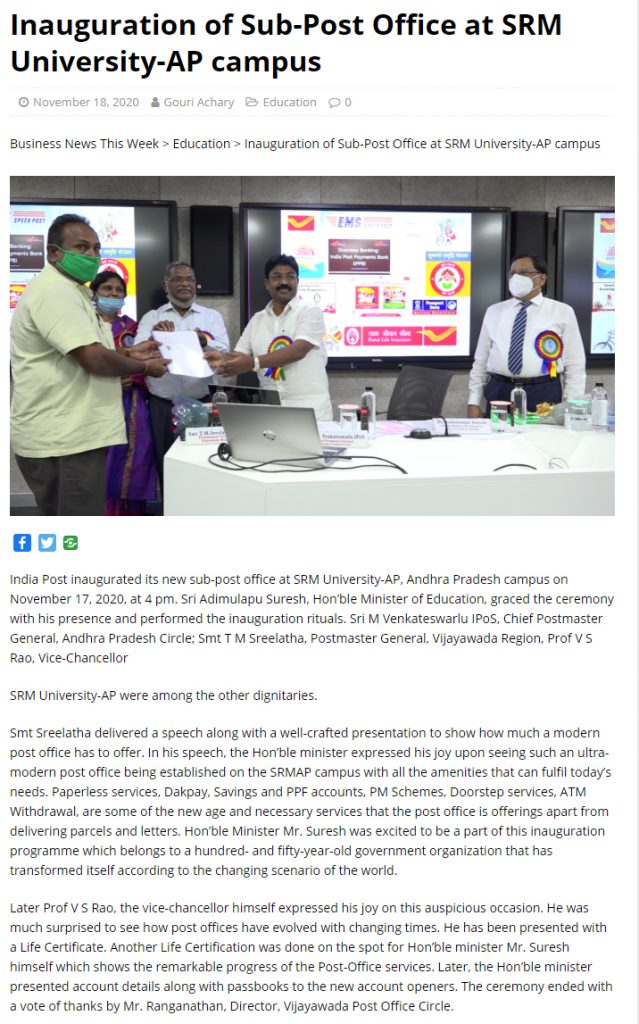
- Dr Lakhveer Singh’s impactful research proposes remedial strategies for mitigating phthalate pollution November 18, 2020
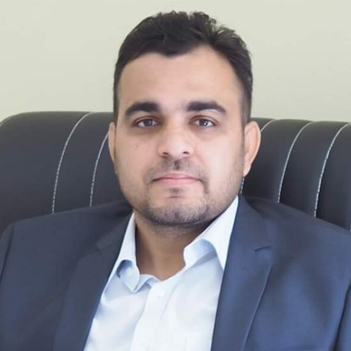 Dr Lakhveer Singh, Assistant Professor, Department of Environmental Science, SRM University-AP, Andhra Pradesh published an article titled “Remediation strategies for mitigation of phthalate pollution: Challenges and future perspectives” in the Journal of Hazardous Materials, with an Impact Factor of 9.03. In recent times, there has been an escalating concern over the risk of phthalate exposure leading to adverse effects on human health and the environment. Dr Lakhveer acknowledged the necessity of understanding the current status of phthalate pollution, their sources, exposure routes, and health impacts, along with understanding the remediation technologies for mitigating such issues.
Dr Lakhveer Singh, Assistant Professor, Department of Environmental Science, SRM University-AP, Andhra Pradesh published an article titled “Remediation strategies for mitigation of phthalate pollution: Challenges and future perspectives” in the Journal of Hazardous Materials, with an Impact Factor of 9.03. In recent times, there has been an escalating concern over the risk of phthalate exposure leading to adverse effects on human health and the environment. Dr Lakhveer acknowledged the necessity of understanding the current status of phthalate pollution, their sources, exposure routes, and health impacts, along with understanding the remediation technologies for mitigating such issues.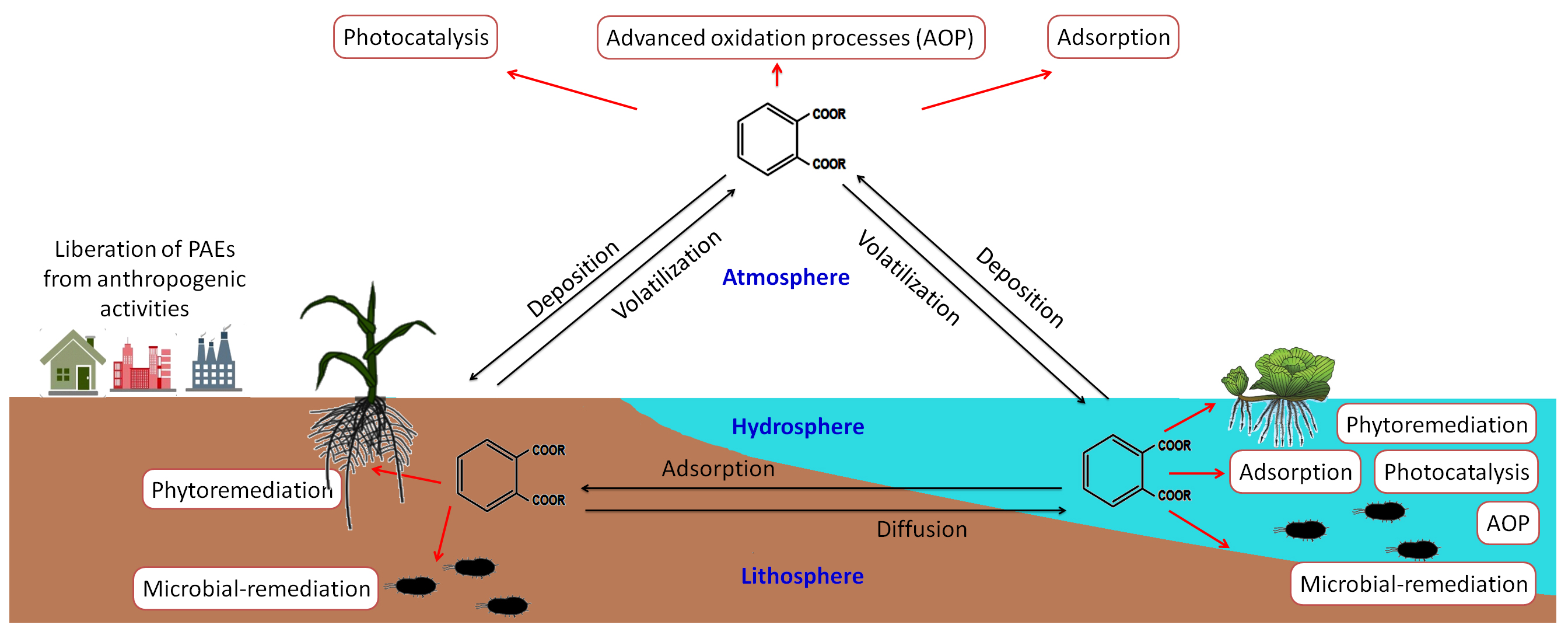 In this collaborative work between Indian Institute of Technology, Delhi, Jawaharlal Nehru University, and SRM AP, Dr Lakhveer enumerates the major phthalates in use today, shares insights on the ever-increasing data on health burdens posed by phthalates and simultaneously, highlights the recent advancements in research to alleviate phthalate contamination from the environment. Tracing their environmental fate, he addresses the growing health hazard concerns imposed by phthalates, along with focusing on understanding the different physical, chemical, and biological treatment of phthalates that are currently being used.
In this collaborative work between Indian Institute of Technology, Delhi, Jawaharlal Nehru University, and SRM AP, Dr Lakhveer enumerates the major phthalates in use today, shares insights on the ever-increasing data on health burdens posed by phthalates and simultaneously, highlights the recent advancements in research to alleviate phthalate contamination from the environment. Tracing their environmental fate, he addresses the growing health hazard concerns imposed by phthalates, along with focusing on understanding the different physical, chemical, and biological treatment of phthalates that are currently being used.Dr Lakhveer explains, “Depending on the degree and nature of contamination, PAEs can be eliminated from different environmental matrices via various available processes such as adsorption, coagulation-flocculation, microbial biodegradation, phytoremediation, photocatalysis, and advanced oxidation processes. However, the efficiency of all these processes depends on various factors including inherent Physico-chemical nature of phthalates, environmental factors, and technological sufficiency.” Thus, advancing his research work in the future, Dr Lakhveer will opt for a holistic approach to develop novel processes for the remediation.
Continue reading → - Dr Tousif Khan N elected as a Joint Secretary of ACDOS November 17, 2020
 Dr Tousif Khan N, Head of the Department, Electrical and Electronics Engineering at SRM University-AP, Andhra Pradesh has been elected as a Joint Secretary (2020-2023) of the prestigious Automatic Control and Dynamic Optimization Society (ACDOS), Indian national member organization of International Federation of Automatic Control (IFAC). The objective of ACDOS is to promote automatic control and dynamic optimization fields in academia and industry across India. The society aims to host international conferences and technical workshops regularly in order to promote close interaction between industry professionals and academia. The society also participates in curriculum development for graduate and under-graduate studies in addition to facilitating productive research in this area. The society volunteers to honour eminent persons who excelled in this field in industry and academic circles.
Dr Tousif Khan N, Head of the Department, Electrical and Electronics Engineering at SRM University-AP, Andhra Pradesh has been elected as a Joint Secretary (2020-2023) of the prestigious Automatic Control and Dynamic Optimization Society (ACDOS), Indian national member organization of International Federation of Automatic Control (IFAC). The objective of ACDOS is to promote automatic control and dynamic optimization fields in academia and industry across India. The society aims to host international conferences and technical workshops regularly in order to promote close interaction between industry professionals and academia. The society also participates in curriculum development for graduate and under-graduate studies in addition to facilitating productive research in this area. The society volunteers to honour eminent persons who excelled in this field in industry and academic circles. Dr Tousif Khan N is an Assistant Professor in the Department of Electronics and Electrical Engineering at SRM University-AP, Andhra Pradesh. He has obtained his PhD from Indian Institute of Technology, Guwahati. Apart from performing his duties as a teacher, he is pursuing his research career in Control systems, Power Electronics and Optimization Techniques. The very young and talented professor has been honoured with several awards and recognitions for his pursuits in the domains of Teaching and Research. As a Joint Secretary of ACDOS, Dr Khan wishes to contribute further to the versatile worlds of Research and Academia.
The other members of ACDOS are eminent researchers and scientists such as Prof. Sukumar Mishra (IIT Delhi) as President, Dr Jayesh Barve (GE, Bangalore) as Vice-President and President-Elect, Dr Shaik Faruque Ali (IIT Madras) Vice-President, Prof Bidyadhar Subudhi (IIT Goa) as Vice-President, Dr Arnab Maity (IIT Bombay) as General Secretary, Dr S. N Omkar (IISc-Bangalore) as Treasurer and Prof Radhakant Padhi (IISc Bangalore) as Director of Operations.
To know more about ACDOS, please click the link: https://www.acdos.org/
Continue reading →

